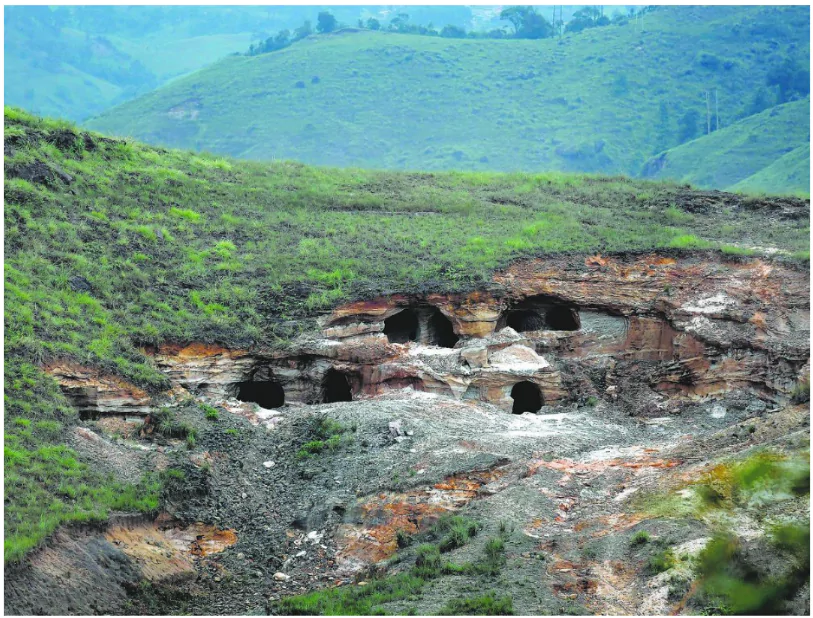Recently, several workers have been trapped in a coal “rat-hole” mine after it was flooded with water in Dima Hasao district of Assam.
What is Rat-Hole Mining?
- A primitive and illegal coal mining technique involving the creation of narrow tunnels, called “rat holes,” which are barely wide enough for a single person.
- Workers manually extract coal using basic tools like pickaxes and shovels.
- Commonly practiced in India’s northeastern states, particularly in Meghalaya.
Enroll now for UPSC Online Course

Types of Rat-Hole Mining
- Side-Cutting Procedure:
- Tunnels are dug into hill slopes to locate thin coal seams, often less than 2 meters thick.
- Coal is manually extracted from these tunnels.
- Box-Cutting Procedure:
- A rectangular opening (10–100 sqm) is made to dig a vertical pit (100–400 feet deep).
- Horizontal tunnels are created for coal extraction once the coal seam is found.
Causes of Rat-Hole Mining
- Economic Factors:
- Poverty and lack of alternative livelihood opportunities drive local populations to engage in rat-hole mining.
- The quick cash generated from coal extraction incentivizes this hazardous practice despite the risks involved.
- Land Ownership Issues:
- Ambiguous land ownership titles create regulatory loopholes that allow illegal mining to persist.
- Coal Demand:
- The constant demand for coal, both legal and illegal, sustains the practice.
- Middlemen and illegal traders perpetuate the cycle, putting miners’ lives at risk.
- Policy Gaps:
- Weak enforcement of regulations and oversight allows illegal operators to exploit the system.
- Special provisions like Article 371A in Nagaland complicate government efforts to regulate mining activities on privately owned land.
Key Issues with Rat-Hole Mining
- Human Safety Concerns:
- Narrow tunnels are prone to collapses, trapping miners underground.
- Poor ventilation leads to suffocation and exposure to hazardous gases.
- Lack of safety equipment increases the risk of accidents and diseases.
- Environmental Impact:
- Deforestation: Trees are cleared to create access points.
Check Out UPSC NCERT Textbooks From PW Store
| Acid mine drainage (AMD), also known as acid rock drainage (ARD), is a naturally occurring process that produces acidic water and metal-rich solutions when sulfide-bearing minerals are exposed to air, moisture, and bacteria during mining. |
-
- Land Degradation: Unplanned digging scars the landscape and erodes topsoil.
- Water Pollution: Acid Mine Drainage (AMD) Causes water contamination and biodiversity loss.
- Air Pollution: Results from coal burning and inadequate ventilation. Social Concerns:
- Child labor is common due to the small size of tunnels.
- Displacement of local communities leads to loss of livelihoods.
Regulatory Framework
- National Green Tribunal (NGT) Ban:
- The National Green Tribunal (NGT) banned the practice in 2014, and retained the ban in 2015 in Meghalaya, citing safety concerns and environmental degradation.
- Despite the ban, illegal mining continues due to weak enforcement and economic dependence.
- Nagaland’s Coal Mining Policy (2006):
- Nagaland permits regulated small-scale mining under its 2006 policy.
- Licenses are granted for limited durations and conditions, but illegal mining persists due to inadequate oversight.
Way Forwards
- Livelihood Alternatives: Providing sustainable income sources such as skill development programs, tourism, and handicrafts can help communities move away from mining.
- Microfinance opportunities can support alternative ventures.
- Sustainable Mining Practices: Exploring safer methods like bord-and-pillar mining or small-scale mechanized mining can reduce risks while maintaining economic viability.
- Strengthening Enforcement: Strict penalties and enhanced monitoring systems are needed to curb illegal mining activities.
- Regulatory bodies should be empowered with the necessary resources for effective oversight.
- Promoting Renewable Energy: Investments in renewable energy sources like solar and wind power can reduce dependence on coal mining.
- Community Empowerment: Raising awareness about the risks of rat-hole mining and providing training programs for safer practices are essential.
Enroll now for UPSC Online Classes
Conclusion
Rat-hole mining remains a pressing issue in India, driven by economic necessity and regulatory gaps. A multi-pronged approach that combines strict enforcement, sustainable livelihoods, modern mining techniques, and investments in renewable energy is crucial to phase out rat-hole mining while ensuring the well-being of affected communities.
![]() 8 Jan 2025
8 Jan 2025


